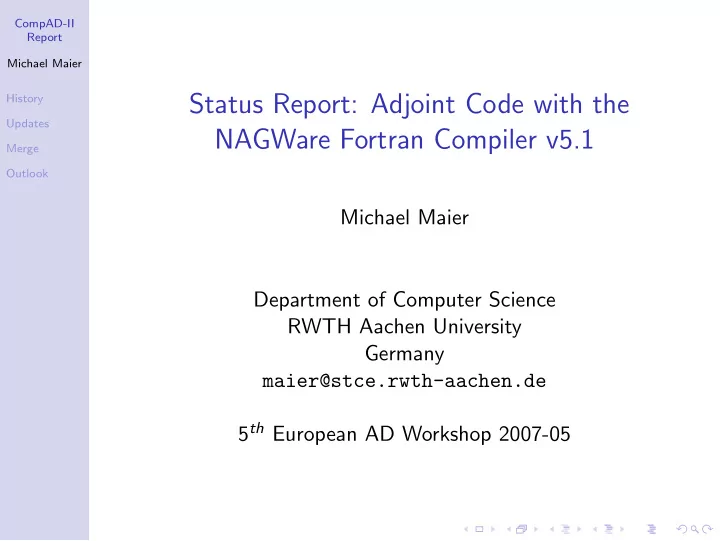

CompAD-II Report Michael Maier Status Report: Adjoint Code with the History Updates NAGWare Fortran Compiler v5.1 Merge Outlook Michael Maier Department of Computer Science RWTH Aachen University Germany maier@stce.rwth-aachen.de 5 th European AD Workshop 2007-05
CompAD-II Report Contents Michael Maier History Updates Merge 1 History & Overview Outlook 2 Source Transformation Updates 3 Merge 4 Outlook
CompAD-II Report History & Overview Michael Maier History • Prototype 1: Forward Mode Updates • using overloading mechanism Merge Outlook J. Riehme , M. Cohen and U. Naumann : Towards Differentiation-Enabled Fortran 95 Compiler Technology . Proceedings of the 2003 ACM Symposium on Applied Computing . 2003. • Prototype 2: Forward Mode • preaccumulation on statement level U. Naumann and J. Riehme : A Differentiation-Enabled Fortran 95 Compiler . ACM Transactions on Mathematical Software , vol. 31, pages 1–16. 2005.
CompAD-II Report History & Overview Michael Maier History Updates Merge • Prototype 3: Reverse Mode Outlook • using interpretation of tape U. Naumann and J. Riehme : Computing Adjoints with the NAGWare Fortran 95 Compiler . H. B¨ ucker , G. Corliss , P. Hovland , U. Naumann , B. Norris , editors: Automatic Differentiation: Applications, Theory, and Tools, Lecture Notes in Computational Science and Engineering , vol. 50. Springer, 2005.
CompAD-II Report History & Overview Michael Maier History Prototype 4: Reverse mode through direct PT Updates transformations: Merge • based on NAGWare F95 compiler sources v4.3 Outlook • own C++ object-oriented interface to the compiler API • association by name • intra procedural transformation of subroutines • does control-flow reversal (loops, branches) • does data-flow reversal • supports basic subset of Fortran operators and functions: • + , - , * , / , ** , • sin , cos , exp , sqrt , • pass-thru for data conversion methods, e.g. dble • supports vectors
CompAD-II Report History & Overview Michael Maier History Prototype 4: Reverse mode example: Updates Merge Input Code → Transformed AD (unparsed PT) Outlook c = SIN (a) CALL DATAPUSH(dummy) 1 dummy = SIN (a) 2 CALL DATAPUSH(c) 3 c = dummy 4 CALL DATAPOP(c) 5 dummy adj = dummy adj + c adj 6 c adj = 0 7 CALL DATAPOP(dummy) 8 a adj = a adj & 9 + dummy adj * COS (a) & . dummy adj = 0 1 0
CompAD-II Report History & Overview Michael Maier • Published in Proceedings of ECT 2006 : History Updates • covers generation of intraprocedural adjoint code • theoretical background Merge • examples of code transformation Outlook • details on data- and control-flow reversal • software development issues • case studies M. Maier and U. Naumann : Intraprocedural Adjoint Code Generated by the Differentiation-Enabled NAGWare Fortran Compiler . In G. M. B.H.V. Topping and R. Montenegro, editors, Proceedings of Fifth International Conference on Engineering Computational Technology , paper 112. Civil-Comp Press, Kippen, Stirlingshire, UK, 2006. Also available under AIB-2006-03, visit: http://aib.informatik.rwth-aachen.de/
CompAD-II Report Migration to Compiler Sources Michael Maier v5.1 History Updates Merge Outlook • resolved several problems due to migration, including: • adjusting insertion of new symbols • adjusting resolution of generic calls • adjusting insertion of intrinsic function • setting internal flags • re-engineered & optimised C++ interface → optimised transformation algorithms • restored functionality as described in ECT2006 paper
CompAD-II Report Association by Address Michael Maier History • replaced association by name by association by address : Updates • introduced user type COMPAD TYPE (via module), Merge having (at least) one VAL and DRV component Outlook → variable activation • operations on active variables are replaced by operations on their VAL component • adjoint code assigns sensitivities to DRV components • advantages: • users can write own COMPAD TYPE implementation with special semantics • supplied pure COMPAD TYPE implements VAL and DRV components of type DOUBLE PRECISION → reverse AD without any overhead • supplied forward mode COMPAD TYPE using operator overloading enables direct computation of second-order derivatives
CompAD-II Report Association by Address Michael Maier History Association by Name (Review): Updates Merge Input Code → Transformed AD (unparsed PT) Outlook c = SIN (a) CALL DATAPUSH(dummy) 1 dummy = SIN (a) 2 CALL DATAPUSH(c) 3 c = dummy 4 CALL DATAPOP(c) 5 dummy adj = dummy adj + c adj 6 c adj = 0 7 CALL DATAPOP(dummy) 8 a adj = a adj & 9 + dummy adj * COS (a) & . dummy adj = 0 1 0
CompAD-II Report Association by Address Michael Maier History Example: Updates Merge Input Code → Transformed AD (unparsed PT) Outlook c = SIN (a) CALL DATAPUSH(dummy%val) 1 dummy%val = SIN (a%val) 2 CALL DATAPUSH(c%val) 3 c%val = dummy%val 4 CALL DATAPOP(c%val) 5 dummy%drv = dummy%drv + c%drv 6 c%drv = 0 7 CALL DATAPOP(dummy%val) 8 a%drv = a%drv & 9 + dummy%drv * COS (a%val) & . dummy%drv = 0 1 0
CompAD-II Report Merge Michael Maier History • branch 1 : Updates AD transformation of parse tree (as described) Merge • branch 2 : Outlook overloading module & automatic variable activation → cf. talk: J. Riehme : Second-Order Adjoints with the NAGWare Fortran 95 Compiler . 5 th European Workshop on Automatic Differentiation , University of Hertfordshire, UK, May 22nd, 2005. • merged branches • automatic activation of variables • automatic use of modules • robust overloading • extensive test suite from 2nd branch • second-order adjoints
CompAD-II Report Outlook Michael Maier History Updates Merge • focus on checkpointing Outlook • inter procedural source transformations • currently: copy on definition (overwrite) → in some cases copy on use? • generic COMPAD TYPE layout → no restrictions on names of component etc. • extensive tests • covering the Fortran Standard in source transformation
Recommend
More recommend